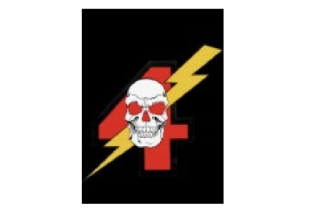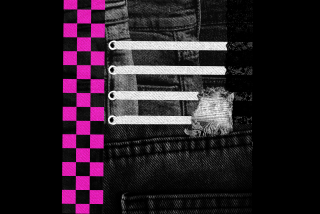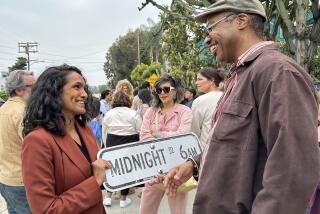Skinheads Who Try to Do Right Thing : Not all youths sporting close-cropped hair and wearing combat boots are neo-Nazi thugs, and some are even organizing to clean up their racist, violent image.
Subdued in a manner belying their image, about 50 “skinheads” gathered at a San Fernando Valley park on a recent Saturday to listen in respectful silence to the words of one of their leaders.
“Wear your (identity) with pride,” said Todd Schwartz, glancing at his yellow armband. “You got to know who and what you are.”
Meet the self-described anti-racist skinheads, a breed apart from the better-known, hard-core variety. While they share many of the same interests of other skinheads, they also claim to pursue racial harmony and pacifism.
Indeed, certain elements of these youths’ appearances made them readily identifiable as partisans of the youth subculture whose name of late has become almost synonymous with neo-Nazism. Nearly all of the boys and many of the girls sported short-cropped hair. Most wore combat boots. Many wore odd-colored suspenders.
But scattered among what has come to be widely regarded as such easily recognizable symbols of defiance were some surprises as well. More than a third of the youths in the park were black, Latino or Asian. And they sported yellow armbands marked with the letters SHARP, an acronym for Skinheads Against Racial Prejudice.
“Real skinheads aren’t racist,” said Iby Miranda, 16, a dark-skinned Latino high school student who favors short hair and black army boots. “Those who are are just bald punks.”
Amid the barrage of media coverage depicting skinheads as neo-Nazi thugs, this new voice is quietly attempting to gather strength.
Members of these groups claim there are hundreds of anti-racist skinheads in Southern California. To make their points they are meeting in parks, picketing at concerts, distributing leaflets, recruiting members, holding rallies, publishing newsletters and generally conducting an aggressive grass-roots public relations campaign to get the word out that not all skinheads are racist.
“We’re providing the kids with an alternative,” said Schwartz, 21.
A U.S. Marine with the rank of lance corporal based at Camp Pendleton, Schwartz--who is Jewish--is the West Coast coordinator of SHARP, one of the largest and most visible of the loosely organized skinhead groups that call themselves “two-tone” to describe their racially integrated membership. Other such groups spotted in Southern California, police say, have included United Skins, the Mickey Mouse Club, the Mods, West Coast Front, Brotherhood Skins, Mad Skins and Anti-Racist Action.
“The Nazis offered them a group,” Schwartz said, “now we’re offering them a group on the other side.”
Roots in ‘60s England
The association between skinheads and racist sentiments goes back at least 20 years to the British working-class neighborhoods in which the gangs of mostly white youth first began appearing. One of their favorite activities back then was beating up on Third World immigrants.
Except for a general identification with the white working class, however, the violence never seemed attached to any particular ideology. That began changing a few years ago when American skinheads started mingling with organized neo-Nazi groups. And indeed, in the last three years law enforcement officials in 24 states have reported violent attacks by hard-core skinheads, whose number they estimate at about 3,500 nationwide.
But two-tone skinheads say they are getting a bum rap. The vast majority of skinheads, Schwartz and others insist, are not neo-Nazi sympathizers at all.
Largely nonviolent, these young people simply consider themselves nonconformists and embody a sort of ethic of individualism, they say. By focusing on the neo-Nazi skinheads, Schwartz said, the media have made life precarious for the others, many of whom have become the unwitting objects of ridicule and hostility that occasionally erupt into attacks on the skinheads.
One ordinarily quiet Long Beach neighborhood, for instance, has been plagued all summer by violent altercations that local skinheads claim are provoked by more conservatively dressed youths ranging from surfers to preppies. The teen-age vigilantes, the skinheads said, attack them, wrongly assuming that they are Nazi sympathizers.
Such anti-racist claims are finding the support of a Southern California psychologist who studied skinheads after counseling some of them for doing poorly in school. After conducting random interviews with more than 150 skinheads over several months at public gatherings in San Francisco, Boston and Los Angeles, psychologist Robert Butterworth said he found fewer than 10% who seemed to hold white supremacist views.
“I got the sense that they are very angry toward the media,” said Butterworth, who has offices in Downey and Los Angeles. “They feel that nobody is listening to their side.”
Many of them are simply young people who have a tremendous need to identify with their peers during the transition from childhood to independence, Butterworth said. “We are making them more dangerous than they really are,” he said. “They have a hard edge, but I don’t see them as hard on the inside.”
Law enforcement officials say they haven’t yet seen any evidence of the “softer” side of skinheads. “The only skinheads who come to our attention are the ones that are (racist),” said Detective Michael Brandt, hate-crime coordinator for the Los Angeles Police Department’s Devonshire Division.
After outgrowing the private San Fernando Valley garage in which it began meeting a year ago, SHARP--whose meetings have reportedly been attended by as many as 200 youths--recently moved its “headquarters” outdoors to the nearby park. Although the majority of members are male, there are also a significant number of female members who play equally active roles.
Schwartz estimates national membership at about 2,000, including 500 in seven California chapters. About 40% of the membership, he said, consists of skinheads who are members of racial and ethnic minorities.
But firm numbers are elusive, Schwartz admits, because the organization--like the life style it represents--remains unstructured.
“It’s all informal networking,” said Schwartz, adding that meetings are announced by word of mouth and activities financed by special collections. “SHARP is more of a belief than an organization.”
While that belief officially shuns violence, many SHARP members say they will fight back against attackers. “We’re passive aggressors,” Miranda explained. “We won’t go out and commit a violent act, but we will defend ourselves.”
That seemed evident in May when the group picketed an appearance at The Country Club--a Reseda concert hall--by the Cro-Mags, a band known to attract Nazi skinheads. Supported by a large crowd, some SHARP members got involved in a series of scuffles that drew coverage by several local television stations. And a protest at the Glendale Masonic Lodge resulted in cancellation of part of a conservative Bible study conference that the protesters considered racist.
The atmosphere during the recent meeting in the park, however, was decidedly nonviolent. Conducted by Schwartz and Greg Lee, a black Granada Hills high school student who oversees the Los Angeles/Valley chapter, the meeting included the announcement of a proposed anti-graffiti project, discussion of an upcoming camp-out at Lake Elsinore and an impromptu birthday party for Schwartz.
Afterward the young skinheads, reveling in their camaraderie through a childlike game of tag, spoke of the dilemma they face.
“I believe in this,” said Paula Lazear, 15, a Reseda high school student of Filipino and French descent. “We’re getting screwed both ways. We’re getting jumped by ‘white power’ and jumped by people who think that we’re ‘white power.’ ”
Dan Jones, a 20-year-old Marine from Camp Pendleton, boiled his philosophy down to a simple equation. “Skinheads are pro-American,” he said. “Nazis don’t support America.”
More to Read
Sign up for Essential California
The most important California stories and recommendations in your inbox every morning.
You may occasionally receive promotional content from the Los Angeles Times.









